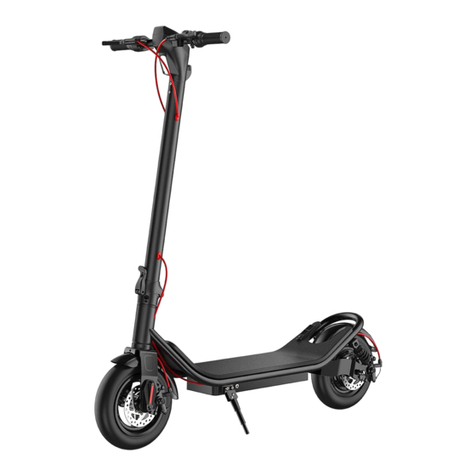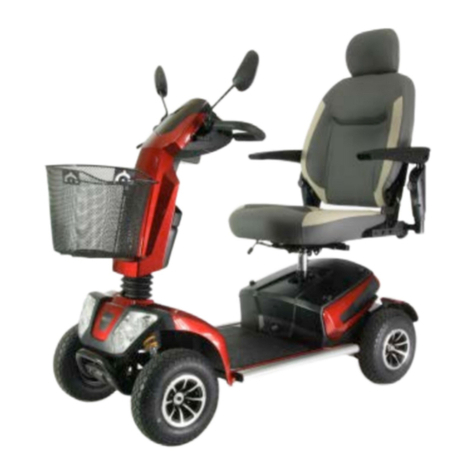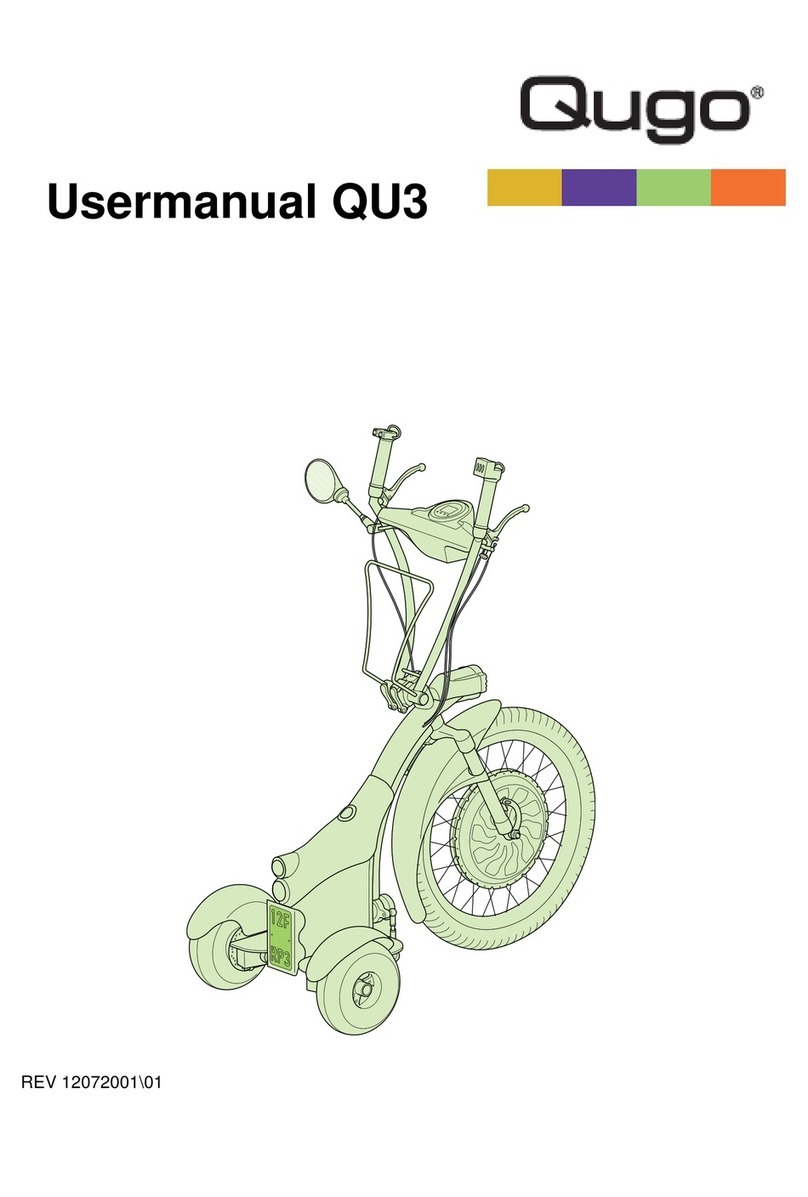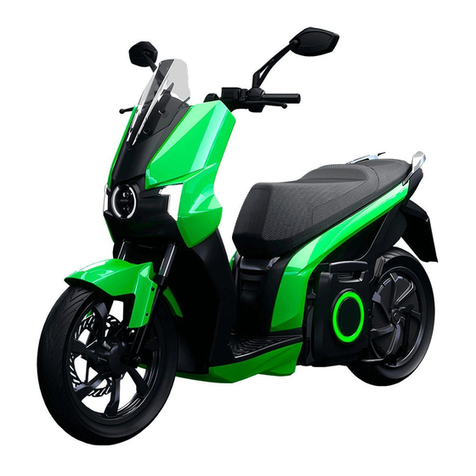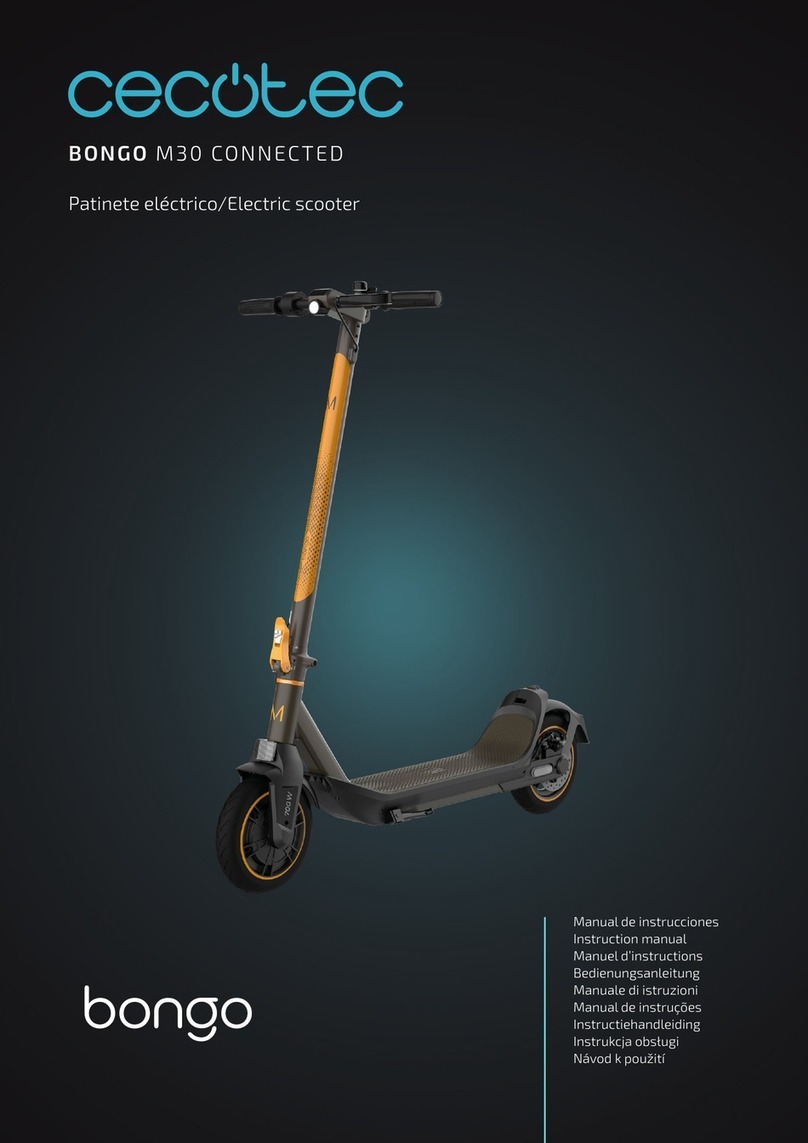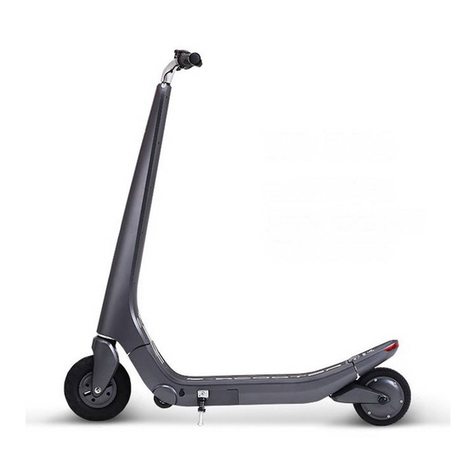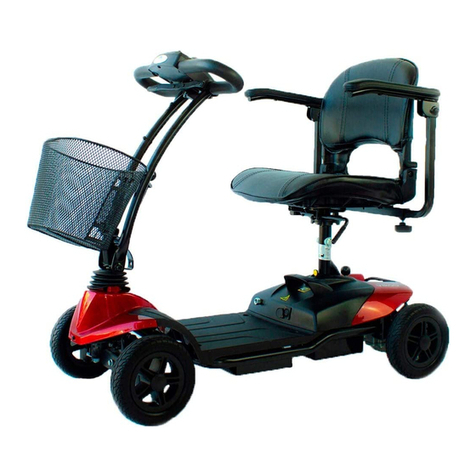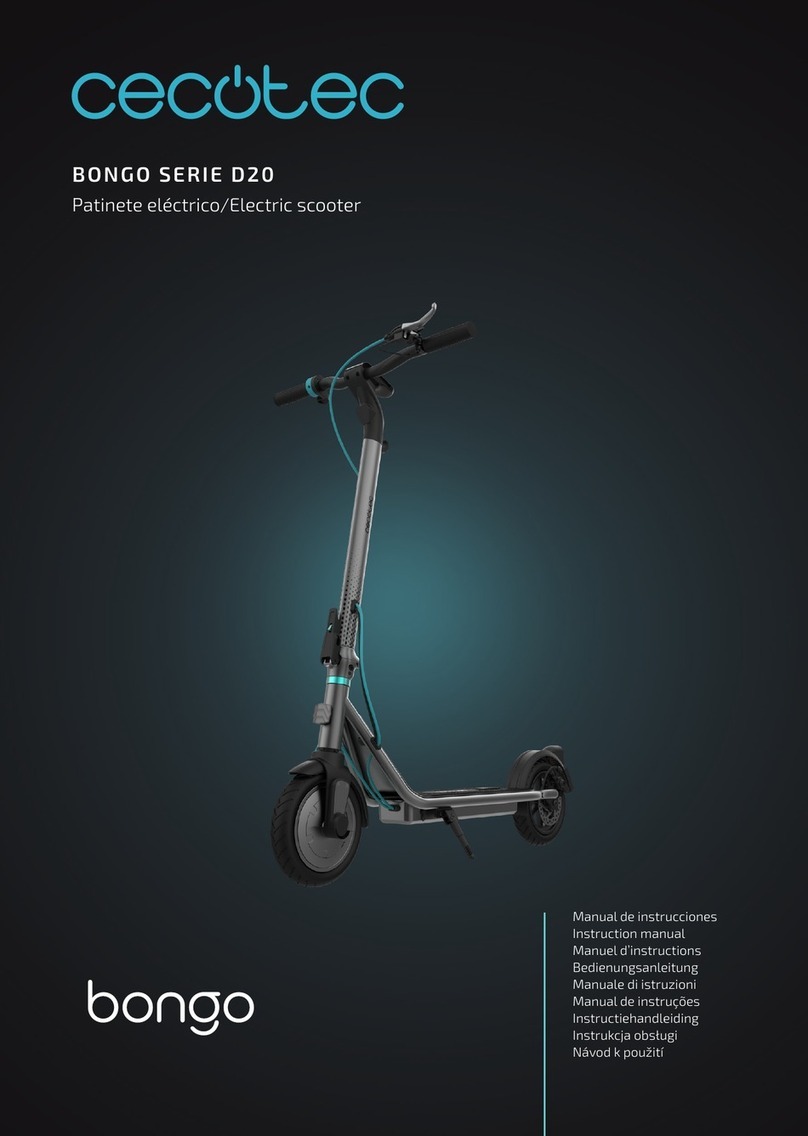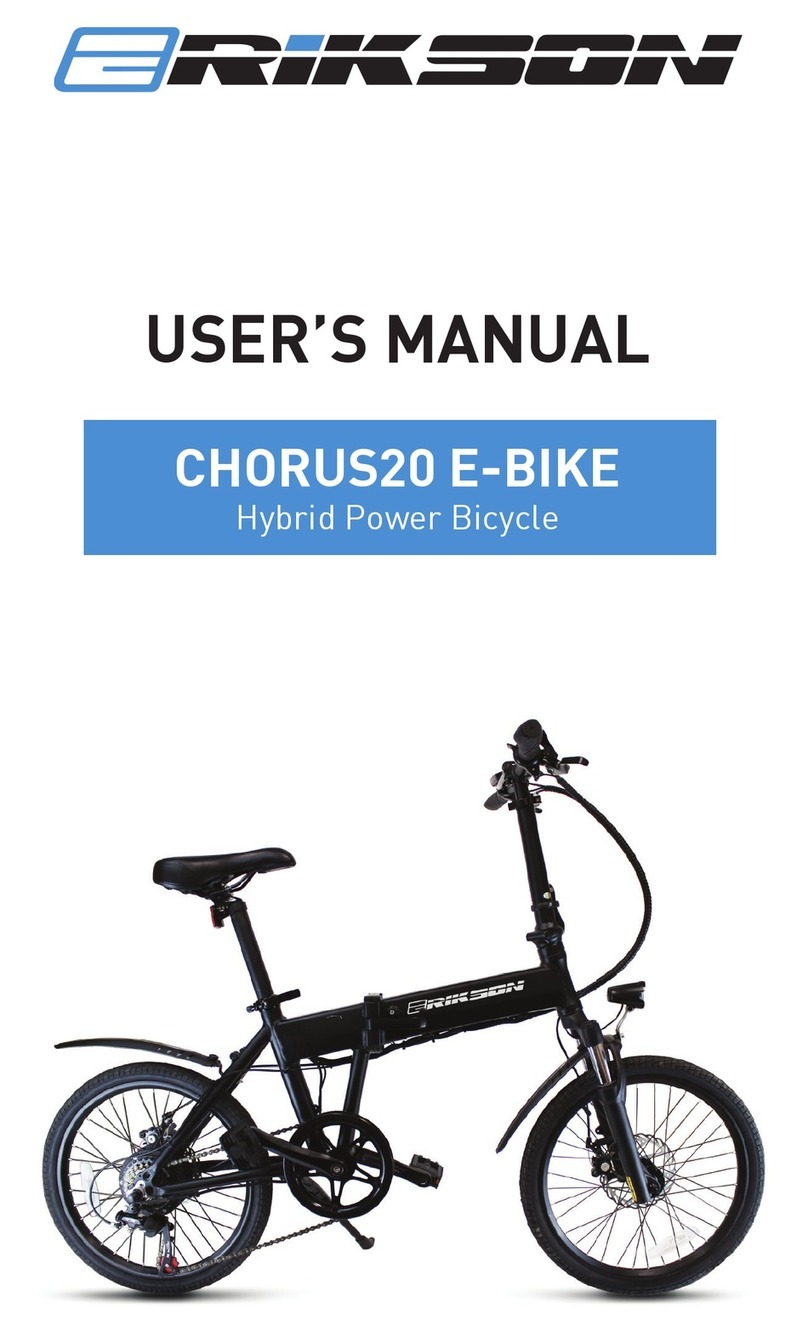DENAGO Model 1 User manual

EBIKE
OWNER’S
MANUAL
CITY MODEL 1 • VERSION 1
This manual meets EN ISO-4210, 16 CFR 1512 and EN 16054 Standards

CITY MODEL 1 • VERSION 1
IMPORTANT:
This manual contains important safety, performance, and service information.
Read it before you take the rst ride on your new eBike and keep it for reference.
Additional safety, performance, and service information for specic components such as
suspension or pedals on your eBike, or for accessories such as helmets or lights that you
purchase, may also be available. Make sure that your dealer has given you all the
manufacturers’ literature that was included with your eBike or accessories. In case of a conict
between the instructions in this manual and information provided by a component
manufacturer, always follow the component manufacturer’s instructions.
If you have any questions or do not understand something, take responsibility for your safety
and consult with BIKE.com at [email protected] or call at 1-(877)-755-2453(BIKE) or visit your dealer
or the eBikes manufacturer.
NOTE:
This manual is not intended as a comprehensive use, service, repair,
1-(877)-755-2453(BIKE) or see your dealer for all service, repair, or maintenance.
Your dealer may also be able to refer you to classes, clinics, or books on eBike use,
service, repair, or maintenance.

page 3 • DENAGO
Contents
GENERAL WARNING p. 4
A special note to parents p. 5
1. First p. 6-10
A. eBike t p. 6
B. Safety rst p. 6-7
C. Anatomy of Your Bike p. 7
D. Mechanical Safety Check p. 7-9
E. First ride p. 9-10
2. Safety p. 11-17
A. The Basics p. 11
B. Riding Safety p. 12-13
C. O Road Safety p. 13
D. Wet Weather Riding p. 13-14
E. Night Riding p. 14-15
F. Extreme, stunt or competition riding p. 15-16
G. Changing Components
or Adding Accessories p. 16-17
H. E-Components p. 17
3.Fit p. 18-23
A. Stand over height p. 18
B. Saddle position p. 19-21
C. Handlebar height and angle p. 22-23
D. Control position adjustments p. 23
E. Brake reach p. 23
4. Tech p. 24-49
A. Wheels p. 24-26
1. Front wheel secondary retention device p. 24-26
2. Wheels with cam action systems p. 27
3. Removing and installing wheel p. 27-31
B. Seat post cam action clamp p. 31-32
C. Brakes p. 32-35
D. Shifting gears p. 35-38
E. Pedals p. 38-40
F. eBike Suspension p. 40
G. Tires and Tubes p. 41-43
H. eBike Components p. 43-48
1. Battery p. 43-45
2. Motor p. 46
3. Throttle p. 47
4. Monitor p. 47
5. Harness p. 48
6. Riding Range of eBike p. 48
5. Service p. 49-52
A. Service Intervals p. 51-53
B. If your eBike sustains an impact p. 53
Appendix A: Teaching Your Child the Rules p. 53-55
Appendix B: Intended Use p. 56-62
Appendix C: Lifespan of your eBike
and its components p. 63-70
Appendix D Fastener Torque Specication p. 71-73
Appendix E Trouble Shooting-BIKE p. 74
Appendix F Trouble Shooting-Monitor p. 75

CITY MODEL 1 • VERSION 1
GENERAL WARNING:
Like any sport, bicycling involves risk of injury and damage. By choosing to ride a eBike, you as-
sume the responsibility for that risk, so you need to know — and to practice — the rules of safe
and responsible riding and of proper use and maintenance.
Proper use and maintenance of your eBike reduces risk of injury.
This Manual contains many “Warnings” and “Cautions” concerning the consequences of failure
to maintain or inspect your eBike and of failure to follow safe cycling practices.
• The combination of the safety alert symbol and the word WARNING indicates a potentially
hazardous situation which, if not avoided, could result in serious injury or death.
• The combination of the safety alert symbol and the word CAUTION indicates a potentially
hazardous situation which, if not avoided, may result in minor or moderate injury, or is an alert
against unsafe practices.
• The word CAUTION used without the safety alert symbol indicates a situation which,
if not avoided, could result in serious damage to the eBike or the voiding of your warranty.
Many of the Warnings and Cautions say, “You may lose control and fall”. Because any fall can
result in serious injury or even death, we do not always repeat the warning of possible injury or
death.
Because it is impossible to anticipate every situation or condition that can occur while riding,
this Manual makes no representation about the safe use of the eBike under all conditions.
There are risks associated with the use of any eBike which cannot be predicted or avoided,
and which are the sole responsibility of the rider.

page 5 • DENAGO
A SPECIAL NOTE FOR PARENTS:
WARNING: This manual covers both Adult and Juvenile, BMX and other types of
youth-sized eBikes. And your child may be sold or may ride an adult-sized eBike as well.
As a parent or guardian, you are responsible for the activities and safety of your minor child, and that
includes making sure that the eBike is properly tted to the child; that it is in good repair and safe
operating condition; that you and your child have learned and understand the safe operation of the
eBike; and that you and your child have learned, understand and obey not only the applicable local
motor vehicle, eBike and trac laws, but also the common sense rules of safe and responsible bicy-
cling. As a parent, you should read this manual, as well as review its warnings and the eBikes func-
tions and operating procedures with your child, before letting your child ride the eBike.
WARNING: Make sure that your child always wears an approved bike helmet when
riding; but also make sure that your child understands that an eBike helmet is for
bicycling only and must be removed when not riding.
A helmet must not be worn while playing, in play areas, on playground equipment,
while climbing trees, or at any time while not riding a eBike.
Failure to follow this warning could result in serious injury or death.
Be aware and understand all rules, regulations, and laws.
Always reference and know your local laws.
https://www.peopleforbikes.org/electric-bikes/policies-and-laws

CITY MODEL 1 • VERSION 1
1. FIRST
NOTE: We strongly urge you to read this manual in its entirety before your rst ride. At the very
least, read and make sure that you understand each point in this section, and refer to the cited
sections on any issue that you don’t completely understand. Please note that not all eBikes have
1-(877)-755-2453(BIKE) or ask your dealer to point out the features of your eBike
A. eBike Fit
1. Is your eBike the right size? To check, see Section 3.A. If your eBike is too large or too small
for you, you may lose control and fall. If your new eBike is not the right size, please contact
exchange it before you ride it.
2. Is the saddle at the right height? To check, see Section 3.B. If you adjust your saddle
height, follow the Minimum Insertion instructions in Section 3.B.
3. Are saddle and seat post securely clamped? A correctly tightened saddle will allow no
saddle movement in any direction. See Section 3.B.
4. Are the stem and handlebars at the right height for you? If not, see Section 3.C.
5. Can you comfortably operate the brakes? If not, you may be able to adjust their angle and
reach. See Section 3.D and 3.E.
6. Do you fully understand how to operate your new eBike? If not, before your rst ride,
dealer explain any functions or features that you do not understand.
B. Safety First
1. Always wear an approved helmet when riding your eBike, and follow the helmet
manufacturer’s instructions for t, use and care.
2. Do you have all the other required and recommended safety equipment? See Section 2.
It’s your responsibility to familiarize yourself with the laws of the areas where you ride, and
to comply with all applicable laws.
3. Do you know how to correctly secure your front and rear wheels? Check Section 4.A.1 to
make sure. Riding with an improperly secured wheel can cause the wheel to wobble or disen-
gage from the eBike and cause serious injury or death.
4. If your eBike has toeclips and straps or clipless (“step-in”) pedals, make sure you know
how they work (see Section 4.E). These pedals require special techniques and skills.
Follow the pedal manufacturer’s instructions for use, adjustment, and care.
5. Do you have “toe overlap”? On smaller framed eBikes your toe or toeclip may be able to
contact the front wheel when a pedal is all the way forward and the wheel is turned. Read
Section 4.E. to check whether you have toeclip overlap.
6. Does your eBike have suspension? If so, check Section 4.F. Suspension can change the way
an eBike performs. Follow the suspension manufacturer’s instructions for use, adjustment,
and care.

page 7 • DENAGO
C. Anatomy of Your Bike
3. Rear Derailleur 4. Chain
5. Crank
7. Pedals
8. Seat Post
9. Saddle
10. Battery
11. Key
13. Seat Clamp QR
14. Stem
f.
Tire
e.
Hub Bolts
d.
Hub Motor
c.
Kickstand
b.
Disc Rotor
a.
Disc Brake
2.
Rear Wheel
1. Fr
ont Wheel
a. Disc Brake
b. Disc Rotor
c. Hub
d. Hub Bolts
e. Tire
D. Mechanical Safety Check
Routinely check the condition of your eBike before every ride.
☐ Nuts, bolts screws & other fasteners: Because manufacturers use a wide variety of fastener
sizes and shapes made in a variety of materials, often diering by model and component, the
correct tightening force or torque cannot be generalized. To make sure that the many fasteners
on your eBike are correctly tightened, refer to the Fastener Torque Specications in Appendix E
of this manual or to the torque specications in the instructions provided by the
manufacturer of the component in question. Correctly tightening a fastener requires a
calibrated torque wrench. A professional eBike mechanic with a torque wrench should torque
the fasteners on you eBike. If you choose to work on your own eBike, you must use a torque
wrench and the correct tightening torque specications from the eBike or component
manufacturer or from your dealer. If you need to make an adjustment at home or in the eld,
we urge you to exercise care, and to have the fasteners you worked on checked by your dealer
as soon as possible.
Note that there are some components that require special tools and knowledge. In Sections 3 and 4
we discuss the items that you may be able to adjust yourself. All other adjustments and repairs should
be done by a qualied eBike mechanic.

CITY MODEL 1 • VERSION 1
WARNING: Correct tightening force on fasteners – nuts, bolts, screws – on your eBike
is important. Too little force, and the fastener may not hold securely. Too much force, and
the fastener can strip threads, stretch, deform, or break. Either way, incorrect tightening
force can result in component failure, which can cause you to lose control and fall.
☐ Make sure nothing is loose. Lift the front wheel o the ground by two or three inches, then
let it bounce on the ground. Anything sound, feel or look loose? Do a visual and tactile
inspection of the whole eBike. Any loose parts or accessories? If so, secure them. If you’re not
sure, ask someone with experience to check.
☐ Tires & Wheels: Make sure tires are correctly inated (see Section 4.G.). Check by putting one
hand on the saddle, one on the intersection of the handlebars and stem, then bouncing your
weight on the eBike while looking at tire deection. Compare what you see with how it looks
when you know the tires are correctly inated; and adjust if necessary.
☐ Tires in good shape? Spin each wheel slowly and look for cuts in the tread and sidewall. Re-
place damaged tires before riding the eBike.
☐ Wheels true? Spin each wheel and check for brake clearance and side-to-side wobble. If a
wheel wobbles side to side even slightly, or rubs against or hits the brake pads, take the eBike to
a qualied eBike shop to have the wheel trued.
CAUTION: Wheels must be true for rim brakes to work eectively. Wheel truing is a
skill that requires special tools and experience. Do not attempt to true a wheel unless you
have the knowledge, experience and tools needed to do the job correctly.
☐ Wheel rims clean and undamaged? Make sure the rims are clean and undamaged at the tire
bead and, if you have rim brakes, along the braking surface. Check to make sure that any rim
wear indicator marking is not visible at any point on the wheel rim.
WARNING: eBike wheel rims are subject to wear. Please contact BIKE.com at cs@bike
.com or call at 1-(877)-755-2453(BIKE) or ask your dealer for all service about wheel rim
wear. Some wheel rims have a rim wear indicator that becomes visible as the rim’s
braking surface wears. A visible rim wear indicator on the side of the wheel rim is an
indication that the wheel rim has reached its maximum usable life.
Riding a wheel that is at the end of its usable life can result in wheel failure,
which can cause you to lose control and fall.
☐ Brakes: Check the brakes for proper operation (see Section 4.C). Squeeze the brake levers.
Are the brake quick-releases closed? All control cables seated and securely engaged?
If you have rim brakes, do the brake pads contact the wheel rim squarely and make full
contact with the rim? Do the brakes begin to engage within an inch of brake lever movement?
Can you apply full braking force at the levers without having them touch the handlebar?
If not, your brakes need adjustment. Do not ride the eBike until the brakes are properly adjusted
by a professional eBike mechanic.
☐ Wheel retention system: Make sure the front and rear wheels are correctly secured.
See Section 4.A.
☐ Seat post: If your seat post has an over-center cam action fastener for easy height
adjustment, check that it is properly adjusted and in the locked position. See Section 4.B.

page 9 • DENAGO
☐ Handlebar and saddle alignment: Make sure the saddle and handlebar stem are parallel to
the eBikes center line and clamped tight enough so that you can’t twist them out of alignment.
See Sections 3.B and 3.C.
☐ Handlebar ends: Make sure the handlebar grips are secure and in good condition, with no
cuts, tears, or worn-out areas. If not, have your dealer replace them. Make sure the handlebar
ends and extensions are covered or have plugs. If not, replace them before you ride.
If the handlebars have bar end extensions, make sure they are clamped tight enough so you
can’t twist them.
WARNING: Loose or damaged handlebar grips or extensions can cause you to lose
control and fall. Unplugged handlebars or extensions can cut you and cause serious injury
in an otherwise minor accident
VERY IMPORTANT SAFETY NOTE:
Please also read and become thoroughly familiar with the important information on the
lifespan of your eBike and its components in Appendix C on Page 64-71
E. First ride
When you buckle on your helmet and go for your rst familiarization ride on your new eBike,
be sure to pick a controlled environment, away from cars, other cyclists, obstacles, or other haz-
ards. Ride to become familiar with the controls, features, and performance of your new eBike.
Familiarize yourself with the braking action of the eBike (see Section 4.C). Test the brakes at slow
speed, putting your weight toward the rear and gently applying the brakes, rear brake rst.
Sudden or excessive application of the front brake could pitch you over the handlebars.
Applying brakes too hard can lock up a wheel, which could cause you to lose control and fall.
Skidding is an example of what can happen when a wheel locks up.
If your eBike has toeclips or clipless pedals, practice getting in and out of the pedals.
See Section 1.B and 4.E.
If your eBike has suspension, familiarize yourself with how the suspension responds to brake
application and rider weight shifts. See paragraph B.6 above and Section 4.F.
Practice shifting the gears (see Section 4.D). Remember to never move the shifter while pedaling
backward, nor pedal backwards immediately after having moved the shifter.
This could jam the chain and cause serious damage to the eBike.
Practice and use in a controlled and safe environment the E-features of the throttle & monitor to
understand how to add the motorized speed and the impacts and eects it has on all aspects of the eBike
features from comfort, to handling, and breaking. Be comfortable and safe, if not consult BIKE.com at
If you have any questions, or if you feel anything about the eBike is not as it should be, consult BIKE.com
at [email protected] or call at 1-(877)-755-2453(BIKE) or ask your dealer your dealer before you ride again.

CITY MODEL 1 • VERSION 1
WARNING: The area in which you ride may require specic safety devices.
It is your responsibility to familiarize yourself with the laws of the area where you ride
and to comply with all applicable laws, including properly equipping yourself and your
eBike as the law requires.
Observe all local eBike laws and regulations. Observe regulations about eBike lighting,
licensing of eBikes, age requirements, riding on sidewalks, laws regulating eBike path and
trail use, helmet laws, child carrier laws, special eBike trac laws. It’s your responsibility
to know and obey the laws.
A. The Basics
1. FIRST
1. Always wear a cycling helmet that meets the latest certication
standards and is appropriate for the type of riding you do.
Always follow the helmet manufacturer’s instructions for t,
use and care of your helmet. Most serious eBike injuries involve
head injuries that might have been avoided if the rider had worn
an appropriate helmet.
WARNING: Failure to wear a helmet when riding may result in serious injury or death.
2. Always do the Mechanical Safety Check (Section 1.D.) before you get on a eBike.
3. 3. Be thoroughly familiar with the controls of your eBike: brakes (Section 4.C.);
pedals (Section 4.E.); shifting (Section 4.D.)
4. Be careful to keep body parts and other objects away from the sharp teeth of chainrings, the
moving chain, the turning pedals and cranks, and the spinning wheels of your eBike.
5. Always wear:
• Shoes that will stay on your feet and will grip the pedals. Make sure that shoelaces cannot
get into moving parts, and never ride barefoot or in sandals.
• Bright, visible clothing that is not so loose that it can be tangled in the eBike
or snagged by objects at the side of the road or trail.
• Protective eyewear, to protect against airborne dirt, dust, and bugs
— tinted when the sun is bright, clear when it’s not.
6. Unless your eBike was specically designed for jumping (See Appendix B, Intended Use) don’t
jump with your eBike. Jumping a eBike, particularly a BMX or mountain eBike, can be fun; but
it can put huge and unpredictable stress on the eBike and its components. Riders who insist
on jumping their eBikes risk serious damage, to their eBikes as well as to themselves. Before
you attempt to jump, do stunt riding or race with your eBike, read and understand Section
2.F.
7. Ride at a speed appropriate for conditions. Higher speed means higher risk.

page 11 • DENAGO
B. Riding Safety
1. Obey all Rules of the Road and all local trac laws.
2. You are sharing the road or the path with others — motorists, pedestrians, and other cyclists.
Respect their rights.
3. Ride defensively. Always assume that others do not see you.
4. Look ahead, and be ready to avoid:
• Vehicles slowing or turning, entering the road or your lane ahead of you, or coming up be-
hind you.
• Parked car doors opening.
• Pedestrians stepping out.
• Children or pets playing near the road.
• Potholes, sewer grating, railroad tracks, expansion joints, road or sidewalk construction,
debris and other obstructions that could cause you to swerve into trac, catch your wheel or
cause you to have an accident.
• The many other hazards and distractions which can occur on an eBike ride.
5. Ride in designated eBike lanes, on designated eBike paths or as close to the edge of the road
as practicable, in the direction of trac ow or as directed by local governing laws.
6. Stop at stop signs and trac lights; slow down and look both ways at street intersections. Re-
member that an eBike always loses in a collision with a motor vehicle, so be prepared to yield
even if you have the right of way.
7. Use approved hand signals for turning
and stopping. (FIG 3)
8. Never ride with headphones. They mask
trac sounds and emergency vehicle
sirens, distract you from concentrating on
what’s going on around you, and their wires
can tangle in the moving parts of the eBike,
causing you to lose control.
9. Never carry a passenger; and, before
installing a child carrier or trailer, check with your dealer or the eBike manufacturer to make
sure the eBike is designed for it. If the eBike is suitable for a child carrier or trailer, make sure
that the carrier or trailer is correctly mounted, and the child is secured and wearing an
approved helmet.
10.Never carry anything which obstructs your vision or your complete control of the eBike,
or which could become entangled in the moving parts of the eBike.
11.Never hitch a ride by holding on to another vehicle.
12.Don’t do stunts, wheelies or jumps. If you intend to do stunts, wheelies, jumps or go racing
with your eBike despite our advice not to read Section 2.F, Downhill, Stunt or Competition
Biking, now. Think carefully about your skills before deciding to take the large risks that go
with this kind of riding.
13. Don’t weave through trac or make any moves that may surprise people with whom you are
sharing the road.
14.Observe and yield the right of way.
15.Never ride your eBike while under the inuence of alcohol or drugs.
16.If possible, avoid riding in bad weather, when visibility is obscured, at dawn, dusk or in the
dark, or when extremely tired. Each of these conditions increases the risk of accident.
Fig. 3

CITY MODEL 1 • VERSION 1
C. Off Road Safety
We recommend that children not ride on rough terrain unless they are accompanied by an adult.
Unless your eBike was specically designed for O Road Riding (See Appendix B, Intended
Use) don’t ride this terrain with your eBike
1. The variable conditions and hazards of o-road riding require close attention and specic
skills. Start slowly on easier terrain and build up your skills. If your eBike has suspension,
the increased speed you may develop also increases your risk of losing control and falling.
Get to know how to handle your eBike safely before trying increased speed or more dicult
terrain.
2. Wear safety gear appropriate to the kind of riding you plan to do.
3. Don’t ride alone in remote areas. Even when riding with others, make sure that someone
knows where you’re going and when you expect to be back.
4. Always take along some kind of identication, so that people know who you are in case of an
accident; and take along some cash for food, a cool drink or an emergency phone call.
5. Yield right of way to pedestrians and animals. Ride in a way that does not frighten
or endanger them and give them enough room so that their unexpected moves don’t
endanger you.
6. Be prepared. If something goes wrong while you’re riding o-road, help may not be close.
7. Before you attempt to jump, do stunt riding or race with your eBike, read and understand
Section 2.F.
Obey the local laws regulating where and how you can ride o-road, and respect private
property. You may be sharing the trail with others — hikers, trail runners, equestrians,
and other cyclists. Respect their rights. Stay on the designated trail. Don’t contribute to erosion
by riding in mud or with unnecessary sliding. Don’t disturb the ecosystem by cutting your own
trail or shortcut through vegetation or streams. It is your responsibility to minimize your
impact on the environment. Leave things as you found them; and always take out everything
you brought in.
Off Road respect
D. Wet Weather Riding
WARNING: Wet weather impairs traction, braking and visibility, both for the bicyclist
and for other vehicles sharing the road. The risk of an accident is dramatically increased
in wet conditions.
Under wet conditions, the stopping power of your brakes (as well as the brakes of other vehicles
sharing the road) is dramatically reduced and your tires don’t grip nearly as well. This makes it
harder to control speed and easier to lose control. To make sure that you can slow down and
stop safely in wet conditions, ride more slowly and apply your brakes earlier and more gradually
than you would under normal, dry conditions. See also Section 4.C.

page 13 • DENAGO
E. Night Riding
Riding an eBike at night is much more dangerous than riding during the day. A bicyclist is very
dicult for motorists and pedestrians to see. Therefore, children should never ride at dawn, at
dusk or at night. Adults who chose to accept the greatly increased risk of riding at dawn, at dusk
or at night need to take extra care both riding and choosing specialized equipment that helps
reduce that risk. Consult your dealer about night riding safety equipment.
WARNING: Reectors are not a substitute for required lights. Riding at dawn, at dusk,
at night or at other times of poor visibility without an adequate eBike lighting system and
without reectors is dangerous and may result in serious injury or death.
eBike reectors are designed to pick up and reect car lights and streetlights in a way that may
help you to be seen and recognized as a moving bicyclist.
CAUTION: Check reectors and their mounting brackets regularly to make sure that
they are clean, straight, unbroken and securely mounted. Have your dealer replace
damaged reectors and straighten or tighten any that are bent or loose.
The mounting brackets of front and rear reectors are often designed as brake straddle
cable safety catches which prevent the straddle cable from catching on the tire tread if the cable
jumps out of its yoke or breaks.
WARNING: Do not remove the front or rear reectors or reector brackets from your
eBike. They are an integral part of the eBikes safety system. Removing the reectors
reduces your visibility to others using the roadway. Being struck by other vehicles may
result in serious injury or death. The reector brackets may protect you from a brake
straddle cable catching on the tire in the event of brake cable failure. If a brake straddle
cable catches on the tire, it can cause the wheel to stop suddenly, causing you to lose
control and fall.
If you choose to ride under conditions of poor visibility, check and be sure you comply
with all local laws about night riding, and take the following strongly recommended additional
precautions:
• Purchase and install battery or generator powered head and taillights which meet all
regulatory requirements for where you live and provide adequate visibility.
• Wear light colored, reective clothing and accessories, such as a reective vest, reective arm
and leg bands, reective stripes on your helmet, ashing lights attached to your body and/or
your eBike ... any reective device or light source that moves will help you get the attention of
approaching motorists, pedestrians, and other trac.
• Make sure your clothing or anything you may be carrying on the eBike does not obstruct a
reector or light.
• Make sure that your eBike is equipped with correctly positioned
and securely mounted reectors.

CITY MODEL 1 • VERSION 1
While riding at dawn, at dusk or at night:
• Ride slowly.
• Avoid dark areas and areas of heavy or fast-moving trac.
• Avoid road hazards.
• If possible, ride on familiar routes.
If riding in trac:
• Be predictable. Ride so that drivers can see you and predict your movements.
• Be alert. Ride defensively and expect the unexpected.
• If you plan to ride in trac often, please contact BIKE.com at [email protected] or call at
1-(877)-755-2453(BIKE) or ask your dealer about trac safety classes or a good book on
eBike/bike trac safety.
F. Extreme, stunt or competition riding
Whether you call it Aggro, Hucking, Freeride, North Shore, Downhill, Jumping, Stunt Riding, Racing,
Enduro or something else: if you engage in this sort of extreme, aggressive riding, you voluntarily
assume a greatly increased risk of injury or death.
Not all eBikes are designed for these types of riding, and those that are may not be suitable for
all types of aggressive riding. Check with your dealer or the eBikes manufacturer about the
suitability of your eBike before engaging in extreme riding.
When riding fast downhill, you can reach speeds achieved by motorcycles, and therefore face
similar hazards and risks. Have your eBike and equipment carefully inspected by a qualied
mechanic and be sure it is in perfect condition. Consult with expert riders, area site personnel
and race ocials on conditions and equipment advisable at the site where you plan to ride.
Wear appropriate safety gear, including an approved full-face helmet, full nger gloves, and
body armor. Ultimately, it is your responsibility to have proper equipment and to be familiar
with course conditions.
WARNING: Although many catalogs, advertisements and articles about bicycling
depict riders engaged in extreme riding, this activity is extremely dangerous, increases
your risk of injury or death, and increases the severity of any injury. Remember that the
action depicted is being performed by professionals with many years of training and
experience. Know your limits and always wear a helmet and other appropriate safety
gear. Even with state-of-the-art protective safety gear, you could be seriously injured
or killed when jumping, stunt riding, riding downhill at speed or in competition

page 15 • DENAGO
WARNING: eBikes and eBike parts have limitations with regard to strength and
integrity, and this type of riding can exceed those limitations or dramatically reduce the
length of their safe use.
We recommend against this type of riding because of the increased risks; but if you choose to
take the risk, at least:
Take lessons from a competent instructor rst
• Start with easy learning exercises and slowly develop your skills before trying more dicult
or dangerous riding
• Use only designated areas for stunts, jumping, racing or fast downhill riding
• Wear a full-face helmet, safety pads and other safety gear
• Understand and recognize that the stresses imposed on your eBike by this kind of activity
may break or damage parts of the eBike and void the warranty
• Take your eBike to your dealer if anything breaks or bends. Do not ride your eBike when any
part is damaged.
If you ride downhill at speed, do stunt riding or ride in competition, know the limits of your skill
and experience. Ultimately, avoiding injury is your responsibility.
G. Changing Components or Adding Accessories
There are many components and accessories available to enhance the comfort, performance,
and appearance of your eBike. However, if you change components or add accessories, you do
so at your own risk. The eBikes manufacturer may not have tested that component or accessory
for compatibility, reliability, or safety on your eBike. Before installing any component or
accessory, including but not limited to a dierent size tire, a lighting system, a luggage rack, a
child seat, a trailer, etc., make sure that it is compatible with your eBike by checking with your
dealer. Be sure to read, understand and follow the instructions that accompany the products
you purchase for your eBike. See also Appendix B, p. 38 and C, p. 44.
WARNING: Failure to conrm compatibility, properly install, operate and maintain
any component or accessory can result in serious injury or death.
WARNING: Exposed springs on the saddle of any eBike tted with a child seat can
cause serious injury to the child.
WARNING: Changing the components on your eBike with other than genuine
replacement parts may compromise the safety of your eBike and may void the warranty.
Check with your dealer before changing the components on your eBike.

CITY MODEL 1 • VERSION 1
H. E-Component
WARNING:The battery pack voltage must match the battery pack charging voltage of
the charger. Otherwise, there is a risk of re and or explosion. ONLY use the factory
provided system of battery and charger.
DO NOT modify alter or make any changes to your E-Components- Battery, Motor,
Monitor, and or Throttle. Any changes, modications and/or altering will void warranty
and could cause injury, serious injury or even death.
Changing the Assistance Level- Changing the E-Assist level while riding will increase or decrease
the acceleration of your eBike. You should show extreme caution and be very familiar with this
system and the changes. Be aware of your surroundings, trac, weather, etc., not traction,
awareness, and overall handling can be inuenced with these changes.
eBikes are heavier than traditional bikes. Be aware. Park to be safe and insure they cannot fall
over or cause damage to you or anyone or your bike.
DO NOT ride of submerge your eBike in water. You could lose control but also could cause
erious damage to your eBike components.
Child Safety - if wishing to use a bike trailer please contact and consult with the trailer
manufacturer to ensure compatibility.
Bicycle Rack for Car - if wishing to use a car rack, trailer hitch rack or any type of device to
transport your eBike please contact and consult the rack manufacturer.
Your eBike is heavy, and you may need a specic and or unique rack.
Be aware and understand all rules, regulations, and laws.
Always reference and know your local laws.
https://www.peopleforbikes.org/electric-bikes/policies-and-laws
If you have any questions, or if you feel anything about the eBike is not as it should be,
or ask your dealer your dealer before you ride

page 17 • DENAGO
A. Stand over height
1. Top Tube frame eBikes
WARNING: If your eBike does not t properly, you may lose control and fall.
If your new eBike doesn’t t, please contact BIKE.com at [email protected] or call at
1-(877)-755-2453(BIKE) or ask your dealer for all service to exchange it before you ride it.
3. Fit
NOTE: Correct t is an essential element of bicycling safety, performance and comfort.
Making the adjustments to your eBike that result in correct t for your body and riding
conditions requires experience, skill, and special tools. Always have your dealer make the
adjustments on your eBike; or, if you have the experience, skill, and tools,
have your dealer check your work before riding.
Stand over height is the basic element of eBike
t (g. 4). It is the distance from the ground to
the top of the eBikes frame at that point where
your crotch is when straddling the eBike.
To check for correct stand over height,
straddle the eBike while wearing the kind of
shoes in which you’ll be riding, and bounce
vigorously on your heels. If your crotch
touches the frame, the eBike is too big for you.
Don’t even ride the eBike around the block.
An eBike which you ride only on paved
surfaces and never take o-road should give
you a minimum stand over height clearance of
two inches (5 cm). An eBike that you’ll ride on
unpaved surfaces should give you a minimum
of three inches (7.5 cm) of stand over height
clearance. And an eBike that you’ll use o road
should give you four inches (10 cm) or more of
clearance.
2. Step-through frame eBikes
Stand over height does not apply to eBikes with step-through frames. Instead, the limiting
dimension is determined by saddle height range. You must be able to adjust your saddle
position as described in 3.B without exceeding the limits set by the height of the top of the seat
tube and the” Minimum Insertion” or “Maximum Extension” mark on the seat post.
Fig. 4

CITY MODEL 1 • VERSION 1
B. Saddle position
Correct saddle adjustment is an important
factor in getting the most performance and
comfort from your eBike. If the saddle position
is not comfortable for you, see your dealer.
The saddle can be adjusted in three directions:
1. Up and down adjustment.
To check for correct saddle height (g. 5):
• sit on the saddle.
• place one heel on a pedal.
• rotate the crank until the pedal with your
heel on it is in the down position and the
crank arm is parallel to the seat tube.
If your leg is not completely straight, your saddle height needs to be adjusted. If your hips must
rock for the heel to reach the pedal, the saddle is too high. If your leg is bent at the knee with
your heel on the pedal, the saddle is too low. Please go step by step to adjust
☐ Loosen the seat post clamp
☐ Raise or lower the seat post in the
seat tube
☐ Make sure the saddle is straight fore
and aft
☐ Re-tighten the seat post clamp to the
recommended torque (Appendix D or the
manufacturer’s instructions).
Once the saddle is at the correct height, make
sure that the seat post does not project from
the frame beyond its “Minimum Insertion”
or “Maximum Extension” mark (FIG. 6).
Fig. 5
Fig. 6

page 19 • DENAGO
NOTE: Some eBikes have a sight hole in the seat tube, the purpose of which is to make it easy to
see whether the seat post is inserted in the seat tube far enough to be safe.
If your eBike has such a sight hole, use it instead of the “Minimum Insertion” or “Maximum
Extension” mark to make sure the seat post is inserted in the seat tube far enough to be visible
through the sight hole.
If your eBike has an interrupted seat tube, as is the case on
some suspension eBikes, you must also make sure that the
seat post is far enough into the frame so that you can touch it
through the bottom of the interrupted seat tube with the tip
of your nger without inserting your nger beyond its rst
knuckle. Also see NOTE above and FIG 7).
WARNING: If your seat post is not inserted in the seat
tube as described in B.1 above, the seat post, binder or
even frame may break, which could cause you to lose
control and fall.
2. Front and back adjustment. The saddle can be adjusted forward or back to help you get the
optimal position on the eBike. Please contact BIKE.com at [email protected] or call at 1-(877)-755-
2453(BIKE) or ask your dealer for all service to set the saddle for your optimal riding position
and to show you how to make this adjustment. If you choose to make your own front and back
adjustment, make sure that the clamp mechanism is clamping on the straight part of the saddle
rails and is not touching the curved part of the rails, and that you are using the recommended
torque on the clamping fastener(s) (Appendix E or the manufacturer’s instructions) through the
sight hole.
3. Saddle angle adjustment. Most people prefer a horizontal saddle; but some riders like the
saddle nose angled up or down just a little. Your dealer can adjust saddle angle or teach you
how to do it. If you choose to make your own saddle angle adjustment and you have a single
bolt saddle clamp on your seat post, it is critical that you loosen the clamp bolt suciently to
allow any serrations on the mechanism to disengage before changing the saddle’s angle, and
then that the serrations fully re-engage before you tighten the clamp bolt to the recommended
torque (Appendix E or the manufacturer’s instructions).
WARNING: When making saddle angle adjustments with a single bolt saddle clamp,
always check to make sure that the serrations on the mating surfaces of the clamp are
not worn. Worn serrations on the clamp can allow the saddle to move, causing you to lose
control and fall.
Always tighten fasteners to the correct torque. Bolts that are too tight can stretch and
deform. Bolts that are too loose can move and fatigue. Either mistake can lead to a
sudden failure of the bolt, causing you to lose control and fall.
Fig. 7

CITY MODEL 1 • VERSION 1
Note: If your eBike is equipped with a suspension seat post, the suspension mechanism
call at 1-(877)-755-2453(BIKE) or ask your dealer for all service for recommended service
intervals for your suspension seat post.
WARNING: After any saddle adjustment, be sure that the saddle adjusting mechanism
is properly seated and tightened before riding. A loose saddle clamp or seat post clamp
can cause damage to the seat post or can cause you to lose control and fall.
A correctly tightened saddle adjusting mechanism will allow no saddle movement in any
direction. Periodically check to make sure that the saddle adjusting mechanism is
properly tightened.
Small changes in saddle position can have a substantial eect on performance and comfort.
To nd your best saddle position, make only one adjustment at a time.
If, in spite of carefully adjusting the saddle height, tilt and fore-and-aft position, your saddle is
still uncomfortable, you may need a dierent saddle design. Saddles, like people, come in many
dierent shapes, sizes and resilience. Your dealer can help you select a saddle which,
when correctly adjusted for your body and riding style, will be comfortable.
WARNING: Some people have claimed that extended riding with a saddle which is
incorrectly adjusted, or which does not support your pelvic area correctly can cause
short-term or long-term injury to nerves and blood vessels, or even impotence.
If your saddle causes you pain, numbness, or other discomfort, listen to your body
and stop riding until you see your dealer about saddle adjustment or a dierent saddle.
or ask your dealer for all service to set the saddle for your optimal riding position
and to show you how to make this adjustment.
If you choose to make your own saddle height adjustment:
Other manuals for Model 1
2
Table of contents
Other DENAGO Scooter manuals

